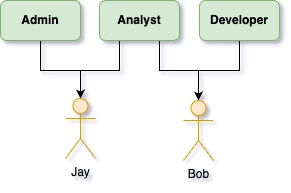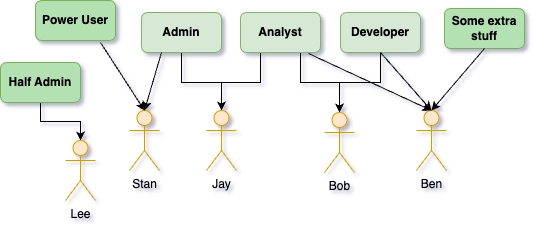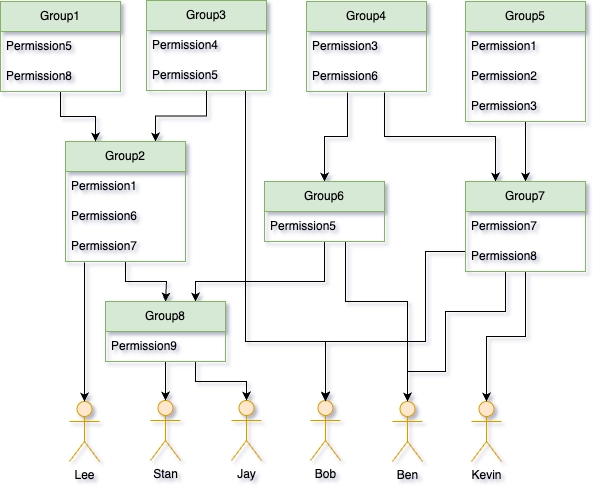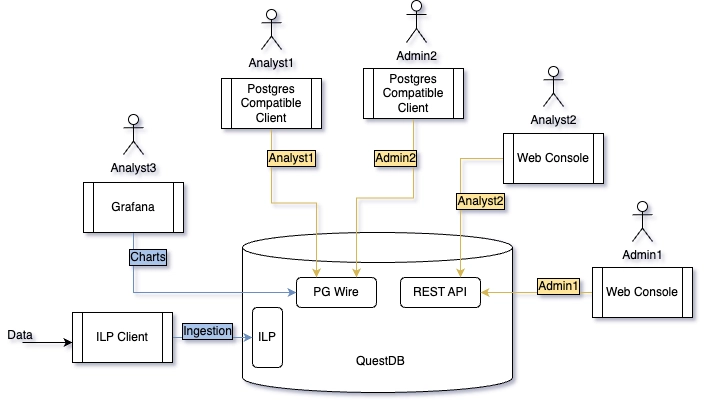Navigating Access Control Design: Pursuing Clarity and Simplicity
When delving into access control system design, one might assume that it is a solved problem and that all the important decisions have already been made. After all, many successful applications already exist, and each of them has solved its own access control challenge. While there is no need to re-invent the wheel, there are many places where innovation can still occur.
To start, let's put access control in simple terms. When a user authenticates themselves, the system reads their permissions and then determines the operations that they are allowed to perform. To help with this, users are often categorized into groups or assigned specific roles, and thus synchronize their permissions with a wider bucket.
While this appears straightforward, nuanced details can significantly impact the overall functionality of an otherwise solid RBAC pattern. In crafting QuestDB's access control solution, we encountered pivotal decisions that shaped our approach.
Groups or Roles?
Our first dilemma lies in naming the entity that we use to organize users into collectives. Role seems like a good choice. A role implies that functionality is bundled and then granted to relevant users who fit the role's description. Roles are created, assigned to users, and their tasks are defined. In a perfect world, it's neat and tidy.

However, here's the catch — unfortunately, reality falls short of perfection!
The initial simplicity soon crumbles as applications evolve, giving rise to a tangled and overlapping assortment of roles. These roles may then stray from their original purpose and lose their authentic alignment with their intended functionalities. Instead, they morph into a jumble of permissions for diverse users.
An analyst might be part developer. One developer may need a single permission that would be destructive in the hands of other another developer. And then you need another admin, but they're only half an admin. It starts clean, but complexity soon catches up. The challenge lies in maintaining clean roles amid this complexity.

While roles appear attractive at first, the term groups tends to offer more flexibility and thus, in theory, greater clarity. Consequently, the integration of both groups and roles often leads to even bigger confusion when inheritance is involved.
Exploring Inheritance
Undoubtedly, groups are essential for efficient access control. Organized groups simplify the process of permission distribution. Access can be granted to a group of users in a single statement. Adding users into that group to then inherit those permissions makes intuitive sense.
However, the necessity of nested group hierarchies warrants a second look. The question is whether to construct an intricate group hierarchy or be content with a singular level of inheritance.
The risk of an intricate hierarchy is that it has the potential to escalate into an unmanageable tree-like structure, or even a complex graph, if the system allows it. These configurations will soon perplex even the most skilled administrators.
Just take a quick look at the example below:

Learning from experience, it became evident that multi-level inheritance results in confusion and mismanagement, thus making it a challenge to trace the origins and implications of permissions. Opting for a single-level inheritance approach groups users well, but without nesting. This promotes transparency and predictability.
Considering Service Accounts
Beyond an administrator's organizational preferences, the application using the database will present its own critical questions that one must consider. For example, should a clear distinction exist between individual and application accounts?
The database logic alone might not necessitate any distinction. But the application accounts may benefit from strict limitations to prevent inadvertent misuse. A common trap is when an application inherits an overly-permissive capability by accident. Depending on how your groups or roles are arranged, it can be easy to do. We need something to help ensure that we do not make this mistake
The creation of service accounts serves this purpose. Service accounts mirror standard users, differing only in their exclusion from group affiliations. Their access is explicitly defined, which prevents unintentional overreach and mis-assignment.
Here is a sample arrangement that shows groups, users, and service accounts:

And the diagram below illustrates how the above users and service accounts could be used to establish connections with the database:

Enabling Real-time Changes
Even with service accounts in place, there are still scenarios where applications may inadvertently impact the database. At times, there is a need for prompt user access revocation. In these difficult scenarios, real-time enforcement of access control changes becomes crucial.
True security must be instantaneous. From a development perspective, it would be convenient to delay or wait until a user reconnects to enforce new permissions. Instead, as a preferred alternative, we will apply a copy-on-write solution. This approach avoids synchronization during permission checks, while changes are safely applied in real time without hindering performance.
By creating a new copy of the access control list when changes are needed, you can ensure that ongoing permission checks proceed without blocking, even during the modification process. Once the changes are ready, the new access control list can be swapped in using an atomic operation, maintaining data consistency and minimizing the impact on performance.
The following code snippets illustrate how copy-on-write can be used to update access lists. First, let's look at the AccessListStore class which holds the access lists, and provides an API for modifications:
class AccessListStore {// the map contains users with their access lists.// an access list is a set of permissions granted to a user.// access lists are versioned: 0, 1, 2, 3...// they also have a flag which indicates if they are still valid or not,// only the access list with the latest version number can be validConcurrentMap<User, AccessList> accessLists;// returns the latest version of the user's access listAccessList getAccessList(User user) {return accessLists.get(user);}// granting a new permission to a uservoid grant(User user, Permission permission) {boolean successful = false;while (!successful) {// lookup the user's access listAccessList current = getAccessList(user);// current: { version = 0, valid = true, permissions=[] }// create a copy of the current access list, only the version is bumpedAccessList next = current.rollVersion();// next: { version = 1, valid = true, permissions=[] }// add the new permission to the cloned access listnext.add(permission);// next: { version = 1, valid = true, permissions=[permission] }// publish the updated access list.// replace is an atomic operation,// it is successful only if current is still in the map.// if current is not in the map anymore, another thread was faster,// and next is based on a stale, invalid access list.// we have to re-try using the latest version as our new current// until we are successful (see the condition of the while loop above).successful = accessLists.replace(user, current, next);// if the access list is successfully updated,// we should invalidate the old version.// anyone using current will see that their version is stale now,// and they should get the updated access list from the map.if (successful) {current.invalidate();}}}}
Then we can look at the SecurityContext class, which belongs to a specific user and can be used to authorize the operations to be executed by the user:
class SecurityContext {User user;AccessListStore accessListStore;// access list holding the user's permissionsAccessList accessList;void authorize(Permission permission) {// refresh access list if it is stale,// check should be executed always on the latest versionif (!accessList.isValid())accessList = accessListStore.getAccessList(user);}// check for the permission,// throw an exception if access is not grantedif (!accessList.hasPermission(permission)) {throw new SecurityException("Access denied");}}}
Conclusion
Innovation consistently finds its space, adapting on top of established solutions, even in thoroughly explored domains such as access control.
These nuanced adjustments can be the differentiating factor that determines whether users of one application either struggle with frustration or feel seamless satisfaction — or, at the very least, experience no added database-related woes!
Want to an easy-to-follow tutorial for QuestDB access control? Checkout our article: QuestDB Enterprise: Role-based Access Control Walkthrough.